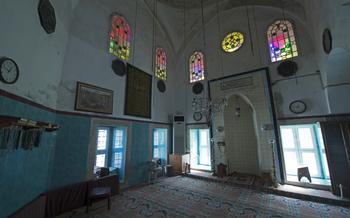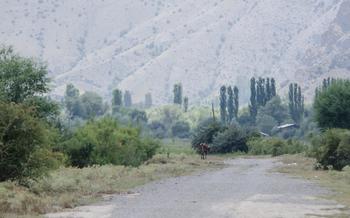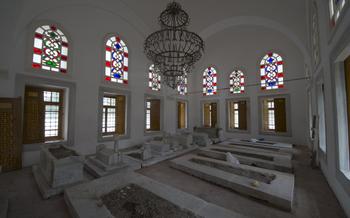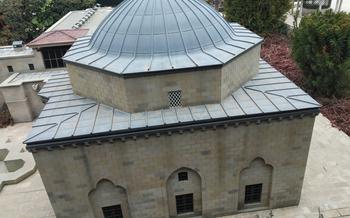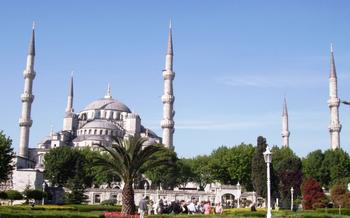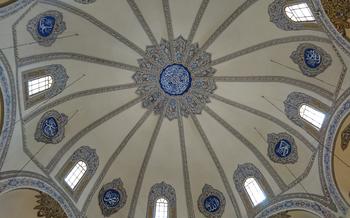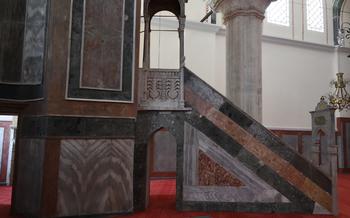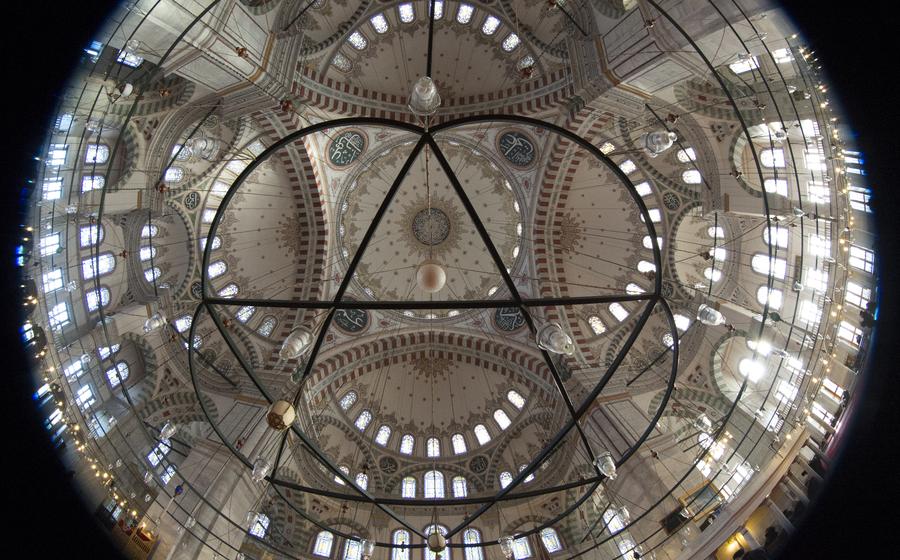
Fatih Mosque
- The Fatih Mosque: A Monumental Masterpiece
- A Journey Through Time: Historical Context
- Architectural Splendor: A Showcase of Ottoman Mastery
- The Prayer Hall: A Place of Serenity and Devotion
- The Courtyard: A Tranquil Oasis in the Bustling City
- The Tombs of Sultan Mehmed II and His Family
- A Living Heritage: The Mosque's Ongoing Significance
- Visiting the Fatih Mosque: Practical Information
- The Call to Prayer: A Mesmerizing Experience
- Capture the Essence: Photography Tips
- Beyond the Mosque: Exploring the Neighborhood
- Local Delights: Culinary Experiences Nearby
- Respecting Local Customs and Traditions
- Insider Tip: Unveiling the Secret Courtyard
The Fatih Mosque: A Monumental Masterpiece
The Fatih Mosque, also known as the Fatih Sultan Mehmet Mosque, stands as a majestic symbol of Istanbul's rich history and architectural splendor. Commissioned by Sultan Mehmed II, the conqueror of Constantinople, the mosque was built between 1463 and 1470 to celebrate the Ottoman triumph and to establish a new imperial mosque in the heart of the newly conquered city.
With its six towering minarets piercing the skyline and its grand dome dominating the cityscape, the Fatih Mosque is a defining landmark of Istanbul. Its impressive dimensions and intricate details showcase the mastery of Ottoman architecture, blending Islamic and Byzantine elements to create a unique and awe-inspiring masterpiece.
The mosque holds immense cultural and religious significance for Muslims worldwide, symbolizing the Ottoman Empire's rise and its commitment to Islamic faith and tradition. It serves as a living testament to Sultan Mehmed II's vision and the enduring legacy of the Ottoman dynasty.
A Journey Through Time: Historical Context
The Fatih Mosque stands as a testament to the remarkable transformation of Istanbul from a Christian stronghold to the vibrant capital of the Ottoman Empire. The fall of Constantinople in 1453, orchestrated by the ambitious Sultan Mehmed II, marked a pivotal moment in history. The conquest signified the end of the Byzantine Empire and the rise of a new Islamic power in the region.
Sultan Mehmed II, also known as Mehmed the Conqueror, envisioned a grand mosque that would symbolize the might and glory of his newly acquired capital. The construction of the Fatih Mosque commenced in 1463, just a decade after the conquest, and was completed in 1470. The mosque was strategically located in the heart of the city, a testament to its significance as a religious and political center.
The Fatih Mosque played a crucial role in the Ottoman Empire's cultural and religious development. It served as a place of worship, education, and community gathering for the Muslim population. The mosque's construction also showcased the Ottomans' architectural prowess and their ability to blend Islamic and Byzantine elements into a harmonious masterpiece.
Throughout Ottoman history, the Fatih Mosque remained a revered symbol of Islamic faith and imperial power. It witnessed the rise and fall of sultans, the ebb and flow of political alliances, and the transformation of Istanbul into a cosmopolitan metropolis. Today, the mosque continues to stand as a living monument to the rich heritage and enduring legacy of the Ottoman Empire.
Architectural Splendor: A Showcase of Ottoman Mastery
The Fatih Mosque stands as a testament to the architectural prowess of the Ottoman Empire. Its sheer size is awe-inspiring, with a vast courtyard, a grand dome, and six towering minarets that dominate the Istanbul skyline. The mosque's exterior is adorned with intricate tilework, calligraphy, and carvings, showcasing the exquisite craftsmanship of Ottoman artisans.
Upon entering the mosque, visitors are greeted by a breathtaking interior. The vast prayer hall is supported by massive columns and arches, creating a sense of grandeur and spaciousness. The walls and ceiling are adorned with intricate designs and patterns, including verses from the Quran and the names of Allah and the Prophet Muhammad. The stunning dome, the focal point of the mosque, is a marvel of engineering and aesthetics, supported by four massive pillars and decorated with vibrant tiles.
The Fatih Mosque is a harmonious blend of Islamic and Byzantine architectural elements. The pointed arches, domes, and minarets are reminiscent of Islamic architecture, while the use of marble, columns, and mosaics echoes the Byzantine style. This fusion of architectural traditions reflects the Ottoman Empire's position as a bridge between East and West, embracing the cultural influences of both worlds.
The Prayer Hall: A Place of Serenity and Devotion
Step inside the prayer hall of the Fatih Mosque, and you'll be enveloped by a sense of awe and tranquility. The vast interior space, adorned with intricate designs and patterns, creates an atmosphere conducive to prayer and reflection. The walls and ceiling are adorned with verses from the Quran, calligraphy, and colorful tilework, each element contributing to the overall splendor of the hall.
The focal point of the prayer hall is the mihrab, a niche indicating the direction of Mecca. Intricately carved and decorated with colorful tiles, the mihrab serves as a guide for worshippers during prayer. Next to the mihrab is the minbar, a pulpit from which the imam delivers sermons and leads prayers. The minbar is also adorned with intricate carvings and inlay work, reflecting the craftsmanship and attention to detail that went into the construction of the mosque.
The acoustics of the prayer hall are designed to enhance the recitation of the Quran and the call to prayer. The high ceilings and the use of arches and domes create a reverberant effect, amplifying the voices of the imam and the worshippers. The overall effect is one of harmony and spirituality, making the prayer hall a truly special place for Muslims to connect with their faith.
The Courtyard: A Tranquil Oasis in the Bustling City
Amidst the vibrant tapestry of Istanbul's cityscape, the courtyard of the Fatih Mosque offers a sanctuary of tranquility. Enclosed by the mosque's imposing walls, lush gardens, and cascading fountains, it invites visitors to momentarily escape the city's relentless rhythm and immerse themselves in a serene oasis.
The courtyard's central feature is a grand ablution fountain, a testament to the ritual purification that precedes prayer in Islam. Its intricate carvings and flowing water create a soothing symphony that echoes through the courtyard, adding to its peaceful ambiance.
Historically, the courtyard served as a gathering place for the community, where scholars, students, and worshippers would congregate for religious discussions, teachings, and social interactions. This tradition continues today, as the courtyard remains a place for Muslims to connect, share stories, and foster a sense of belonging.
In stark contrast to the bustling streets that surround it, the Fatih Mosque's courtyard exudes an air of tranquility, a serene respite from the city's vibrant energy. It invites visitors to pause, reflect, and appreciate the beauty of simplicity amidst the grandeur of Istanbul's architectural wonders.
The Tombs of Sultan Mehmed II and His Family
Within the Fatih Mosque complex lies a mausoleum housing the elaborate tombs of Sultan Mehmed II, the conqueror of Istanbul, his wife, Gülbahar Hatun, and their children. These tombs are adorned with intricate tilework and calligraphy, showcasing the finest craftsmanship of the Ottoman era.
Sultan Mehmed II's tomb is particularly grand, featuring a hexagonal base and a domed canopy. The walls are covered with exquisite blue and turquoise tiles, adorned with intricate geometric patterns and Quranic verses. The ceiling is adorned with gold-leaf inscriptions, adding to the opulent ambiance of the tomb.
Adjacent to Sultan Mehmed II's tomb is the tomb of his wife, Gülbahar Hatun, who played a significant role in the construction of the mosque. Her tomb is smaller but equally ornate, with blue and white tiles and delicate calligraphy.
The tombs of Sultan Mehmed II's children, Şehzade Mustafa and Şehzade Bayezid, are located nearby. These tombs are also adorned with beautiful tilework and calligraphy, reflecting the respect and affection held for the Ottoman dynasty.
Visiting the tombs of Sultan Mehmed II and his family offers a glimpse into the lives and legacies of these influential figures. The tombs serve as a reminder of the grandeur and power of the Ottoman Empire, and the enduring impact of Sultan Mehmed II's conquest of Istanbul.
A Living Heritage: The Mosque's Ongoing Significance
The Fatih Mosque continues to play a vital role in the religious, cultural, and educational landscape of Turkey. It remains a prominent place of worship for Muslims in Istanbul, attracting thousands of worshippers during daily prayers and especially during Ramadan and other religious festivals. The mosque also serves as a center for Islamic education, with classes and lectures held on various aspects of Islam and its teachings.
Moreover, the Fatih Mosque serves as a community gathering place, hosting events, conferences, and exhibitions related to Islamic culture and history. It is a venue for social and cultural interactions, fostering a sense of community among Muslims in Istanbul and beyond.
In recognition of its exceptional cultural and historical significance, the Fatih Mosque was designated as a UNESCO World Heritage Site in 198This prestigious recognition underscores the mosque's enduring legacy as a symbol of Ottoman architectural mastery and a testament to the rich cultural heritage of Turkey.
The mosque's ongoing significance lies in its ability to bridge the past with the present, serving as a living testament to the grandeur and achievements of the Ottoman Empire while remaining a vibrant and relevant institution in contemporary Turkish society.
Visiting the Fatih Mosque: Practical Information
Location and Accessibility:
The Fatih Mosque is conveniently located in the heart of Istanbul's historic Fatih district, easily accessible by public transportation. The closest tram stop is Fatih, a short walk from the mosque. Alternatively, visitors can take a taxi or ride-sharing service to reach the mosque directly.
Opening Hours and Admission Fees:
The Fatih Mosque is open to visitors daily from 9:00 AM to 5:00 PM, except during prayer times. Admission to the mosque is free of charge, allowing visitors to explore its grandeur without any financial constraints.
Dress Code and Etiquette:
As a place of worship, the Fatih Mosque requires visitors to dress modestly and respectfully. Women are expected to cover their heads with a scarf or headscarf, while men should avoid wearing shorts or tank tops. Additionally, visitors should refrain from talking loudly or engaging in disruptive behavior within the mosque's premises.
Guided Tours and Audio Guides:
For those seeking a deeper understanding of the mosque's history and architecture, guided tours are available in several languages. These tours provide insightful commentary and anecdotes, enhancing the visitor experience. Additionally, audio guides are available for rent, offering a self-guided tour option with informative narration.
Nearby Attractions and Suggested Itineraries:
The Fatih Mosque is surrounded by a wealth of historical and cultural attractions, making it an ideal starting point for exploring Istanbul's rich heritage. Visitors can combine their visit to the mosque with a stroll through the vibrant Grand Bazaar, a labyrinth of shops and stalls selling traditional Turkish goods. The Süleymaniye Mosque, another architectural masterpiece built by Sultan Süleyman the Magnificent, is also within walking distance. To delve deeper into Istanbul's culinary heritage, the Spice Bazaar, filled with aromatic spices and Turkish delights, is a must-visit destination.
The Call to Prayer: A Mesmerizing Experience
The call to prayer, or adhan, is an integral part of Muslim culture and an enchanting experience for visitors to the Fatih Mosque. Five times a day, the muezzin's melodic voice resonates from the mosque's minarets, summoning the faithful to prayer. The adhan is a beautiful blend of Arabic calligraphy and rhythmic chanting, echoing across the rooftops of Istanbul.
As the call to prayer begins, a sense of tranquility descends upon the neighborhood. Passersby stop in their tracks, drivers pull over, and shopkeepers pause their work to face the mosque and listen with reverence. The call is a reminder of the deep faith and devotion that permeates Turkish society.
For non-Muslim visitors, the call to prayer offers a glimpse into the spiritual heart of Istanbul. It's a chance to witness a centuries-old tradition that has remained unchanged for generations. Whether you're a believer or not, the adhan is a mesmerizing experience that will transport you to another time and place.
Tips for Visitors:
- Show respect by standing still and facing the mosque during the call to prayer.
- It's not necessary to participate in the prayer, but it's considered polite to show reverence by maintaining a quiet and respectful demeanor.
- If you're in the mosque during the call to prayer, you can join the congregation in prayer or simply stand quietly and observe.
Capture the Essence: Photography Tips
The Fatih Mosque presents a captivating subject for photography enthusiasts, offering a wealth of intricate details, vibrant colors, and stunning architectural features. To capture the mosque's grandeur effectively, consider the following tips:
Recommended Camera Settings and Lenses: For capturing wide-angle shots of the mosque's exterior, a wide-angle lens is essential. A focal length of 16-35mm is ideal for capturing the mosque's full majesty. For close-up shots of intricate details, such as the tilework or calligraphy, a macro lens or a zoom lens with a focal length of 70-200mm is recommended.
Tips for Capturing Intricate Details and Vibrant Colors: To capture the mosque's vibrant colors and intricate details, shoot in RAW format. This will give you more flexibility when editing your photos and allow you to recover more detail in the shadows and highlights. Use a tripod to stabilize your camera and avoid blurry images, especially when shooting in low-light conditions.
Best Angles and Vantage Points for Panoramic Shots: For panoramic shots of the mosque, find an elevated vantage point, such as the terrace of a nearby building or a hilltop. This will allow you to capture the mosque's grandeur against the backdrop of the city skyline. Use a wide-angle lens and compose your shot carefully to include key features of the mosque and the surrounding cityscape.
Tips for Avoiding Crowds and Capturing Serene Moments: To avoid crowds and capture serene moments of the mosque, visit during the early morning or late afternoon, when the mosque is less crowded. Alternatively, visit during the week, as weekends tend to be busier. If possible, time your visit to coincide with the call to prayer, as this creates a particularly atmospheric and spiritual ambiance.
Beyond the Mosque: Exploring the Neighborhood
Venturing beyond the majestic Fatih Mosque, immerse yourself in the vibrant neighborhood that encapsulates Istanbul's rich history and culture. Explore the labyrinthine streets of the Fatih district, where every corner unveils a new treasure. Discover hidden gems such as the Grand Bazaar, a sprawling marketplace pulsating with the energy of hundreds of vendors selling traditional Turkish goods, spices, and souvenirs. Marvel at the architectural grandeur of the Süleymaniye Mosque, another masterpiece built by the Ottoman sultans, and get lost in the aromatic alleys of the Spice Bazaar, where the air is perfumed with the enticing scents of exotic spices and Turkish delights. Immerse yourself in the local culinary scene by savoring delectable Turkish dishes at traditional restaurants and sampling street food delicacies that tantalize the taste buds. Engage with friendly locals, embrace cultural customs, and create unforgettable memories in this vibrant neighborhood that epitomizes the essence of Istanbul.
Local Delights: Culinary Experiences Nearby
Venturing beyond the architectural wonders of the Fatih Mosque, the surrounding neighborhood offers a tantalizing array of culinary delights. Indulge in the vibrant flavors of Turkish cuisine at local restaurants and cafes, each promising a unique gastronomic journey. Savor the aromatic kebabs, freshly grilled on skewers and infused with a symphony of spices. Delight in the melt-in-your-mouth baklava, a flaky pastry filled with honey-soaked nuts, a testament to Turkey's rich dessert tradition.
For an authentic taste of Istanbul's street food, explore the bustling markets and savor the mouthwatering simit, a sesame-encrusted bread that is a beloved local snack. Sip on a refreshing glass of çay, the ubiquitous Turkish tea, as you soak in the vibrant atmosphere of the neighborhood.
To delve deeper into the culinary heritage of Istanbul, visit the nearby Spice Bazaar, a vibrant marketplace filled with colorful stalls selling an array of aromatic spices, dried fruits, and Turkish delights. Engage with the friendly vendors, learn about the history and uses of various spices, and sample the delectable Turkish delights, a confectionery masterpiece made with nuts, fruits, and a generous dusting of powdered sugar.
Whether you seek a hearty meal, a sweet treat, or a culinary adventure, the neighborhood surrounding the Fatih Mosque offers an unforgettable gastronomic experience, blending traditional flavors with modern culinary delights. Embrace the opportunity to savor the rich tapestry of Turkish cuisine, a true reflection of Istanbul's cultural heritage.
Respecting Local Customs and Traditions
When visiting the Fatih Mosque, it is essential to be mindful of local customs and traditions to show respect for the religious and cultural significance of the site. Here are some tips to ensure a respectful and enjoyable visit:
Dress Modestly: Adhere to modest dressing norms when visiting the mosque. Avoid revealing clothing and opt for attire that covers your shoulders, knees, and chest. This demonstrates respect for the sanctity of the religious site.
Remove Shoes: Before entering the prayer hall, remove your shoes and place them neatly on the designated racks. This is a customary practice to maintain the cleanliness and purity of the mosque's interior.
Maintain Silence: Respect the serene atmosphere of the mosque by keeping your voice low and avoiding unnecessary noise. Silence allows for contemplation and prayer, and it shows respect for other visitors.
Be Mindful of Prayer Times: Be aware of the mosque's prayer times and avoid entering the prayer hall during these periods. This allows worshippers to perform their prayers without distractions.
Ask Permission Before Taking Photos: While photography is generally allowed in the mosque, it is polite to ask permission before taking photos of people, especially if they are engaged in prayer or contemplation.
Interact Respectfully: If you have questions or need assistance, approach the mosque's staff or volunteers politely. Be respectful of their time and avoid interrupting their duties.
By following these guidelines, you can contribute to a harmonious and respectful environment at the Fatih Mosque, showing appreciation for its religious and cultural significance.
Insider Tip: Unveiling the Secret Courtyard
Beyond the main courtyard, the Fatih Mosque holds a hidden gem that often goes unnoticed by visitors: a secret courtyard tucked away behind the mosque's imposing structure. This secluded oasis offers a tranquil escape from the bustling city and a unique perspective of the mosque's grandeur.
To access the secret courtyard, visitors should head to the far end of the main courtyard and look for a small, unmarked doorway. Once through the doorway, they will find themselves in a serene courtyard surrounded by lush gardens and adorned with intricate tilework. The centerpiece of the courtyard is a fountain, providing a soothing backdrop for contemplation and reflection.
The secret courtyard offers stunning views of the mosque's majestic dome and minarets, allowing visitors to appreciate the mosque's architectural beauty from a different angle. It is a perfect spot to capture serene photographs without the crowds that often gather in the main courtyard.
Whether seeking a moment of tranquility or a unique photographic opportunity, the secret courtyard is a hidden gem that should not be missed when visiting the Fatih Mosque. Its secluded atmosphere and stunning views make it a true insider's tip for those seeking an authentic and memorable experience.

